|
|
|
Sort Order |
|
|
|
Items / Page
|
|
|
|
|
|
|
| Srl | Item |
| 1 |
ID:
054135
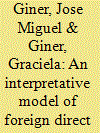

|
|
|
| 2 |
ID:
109996
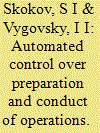

|
|
|
|
|
| Publication |
2011.
|
| Summary/Abstract |
The authors examine an automated control system for preparing and conducting military operations; and identify ways they consider essential for improving control efficiency.
|
|
|
|
|
|
|
|
|
|
|
|
|
|
|
|
| 3 |
ID:
103382


|
|
|
|
|
| Publication |
2011.
|
| Summary/Abstract |
European freight transport emissions and fuel consumption are projected to increase. This study focuses on long distance freight transport (LDFT) and explores possible sustainable futures through quantitative modeling. The evaluation was part of European foresight process between researchers, policy makers and freight companies (FREIGHTVISION). Greenhouse gas (GHG) emissions and energy demand of road, rail and inland waterways were estimated for an EU-27 in 2005. Development was extrapolated to 2050 based on technology and freight performance forecasts. Stakeholders found the forecasted GHG emissions and fossil fuel share unsustainable, so alternative futures were developed with backcasting. The developed emission model was run with random parameter combinations to screen a set of sustainable futures, with an 80% reduction of GHG emissions and fossil fuel share. Freight transport performance was not controlled in the backcasts, but several sustainable futures were found if significant changes in transport efficiency and energy mix are implemented. In spite of agreeing on the importance of reducing emissions, stakeholders had difficulties in choosing a preferred technological future. Simple models were found to be an effective tool for communicating the influence of various measures. Further research is recommended to screen preferable technological roadmaps from the broad range of available futures.
|
|
|
|
|
|
|
|
|
|
|
|
|
|
|
|
| 4 |
ID:
166351
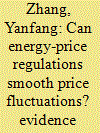

|
|
|
|
|
| Summary/Abstract |
Due to the dominance of coal in China’s energy mix, coal prices have always been a challenging part of pricing reform. The recent frequent government interventions raise the key research questions: what is the actual impact of price policies on coal price fluctuations, and how can forward-looking pricing policies be made. By proposing a novel classification of coal pricing policies and introducing an expectation and forward-looking coefficient, the paper examines the relationship between coal price fluctuations and pricing policies using the generalized method of moments (GMM) method. It shows that the lagging coal price and coal demand play a positive role in regulating coal prices, while coal supply and marketization have significantly negative effects on coal price fluctuations. The heterogeneous impacts of price policies are due to differences in market players’ expectations, policy instruments and the methods of policy release. In addition, China’s coal pricing policy portfolio from 2013 to 2016 exerted synergy effects on the restraint of coal price fluctuations. As the forward-looking coefficient was considerably low, the government's intervention behaviors were obviously biased towards ex post facto responses. The paper suggests short run and long run policies to advance marketization of coal prices amid the energy transition.
|
|
|
|
|
|
|
|
|
|
|
|
|
|
|
|
| 5 |
ID:
098785
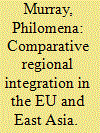

|
|
|
|
|
| Publication |
2010.
|
| Summary/Abstract |
In comparative regional integration (RI) analysis, the European Union's (EU) advancing of its own experience as a model is a significant problem. This article explores this problem by focusing on comparative aspects of RI in the EU and East Asia. It argues that there are important and valid aspects of comparison, such as the origins and objectives of these two regions, but fewer points of comparison between the two when it comes to achieving their objectives. It suggests that historical differences between the two regions constitute the major reason that a direct comparison is neither useful nor productive. It analyses the centrality and the exceptionalism of the EU in much of the comparative RI literature. It agues that the promotion of the EU experience as a form of model or paradigm is far from analytically helpful - the method of comparative analysis needs be the focus of our study as much as the objects of comparison. The article examines how the centrality of the EU in some analysis can amount to a form of de facto snobbery in the positioning of the EU on a rather unsteady pedestal. This 'integration snobbery' - to coin a phrase utilized by an EU official - is not constructive for comparative analysis of the EU and East Asia.
|
|
|
|
|
|
|
|
|
|
|
|
|
|
|
|
| 6 |
ID:
180357


|
|
|
|
|
| Summary/Abstract |
This article analyzes the production and presentation of artworks of three countries of the Gulf Region –– Qatar, the UAE and Saudi Arabia –– to evaluate its place and potential in the globalized artworld. The Gulf region is a small but significant part of the global artworld with high potential for further development. Art globalization in the Gulf began to develop only in the 2000s –– from about 2006 in the UAE, followed by a second wave in Qatar five years later. A third wave is rising with the increasingly international exposure of Saudi Art. The article examines which factors are essential for participation in a globalized art world and whether the region enjoys international recognition on the global stage. A composite artworld ecosystem model comprising institutions, artists and their artworks, commercial entities and government was conceived on a philosophical and sociological basis within a historical and geopolitical framework. The roles of the museum, biennials, art galleries and art fairs, are converging in many respects. All the nodes of the artworld ecosystem are required for globalization, with participation in the biennial model being the most important factor, being more flexible than the museal institutions in funding and programming. To reach a wider audience, the art fair model could be more relevant than the more esoteric biennial format. The Gulf region’s patrons possess strong motivations for supporting the arts of the region internationally. In addition, the desire to enter the global cultural world through the promotion of art museums as a tourist destination is a strong motivator for governments.
|
|
|
|
|
|
|
|
|
|
|
|
|
|
|
|
| 7 |
ID:
116726
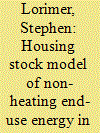

|
|
|
|
|
| Publication |
2012.
|
| Summary/Abstract |
This paper proposes a housing stock model of non-heating end-use energy for England that can be verified using aggregate energy use data available for small areas. These end-uses, commonly referred to as appliances and lighting, are a rapidly increasing part of residential energy demand. This paper proposes a model that can be verified using aggregated data of electricity meters in small areas and census data on housing. Secondly, any differences that open up between major collections of housing could potentially be resolved by using data from frequently updated expenditure surveys. For the year 2008, the model overestimated domestic non-heating energy use at the national scale by 1.5%. This model was then used on the residential sector with various area classifications, which found that rural and suburban areas were generally underestimated by up to 3.3% and urban areas overestimated by up to 5.2% with the notable exception of "professional city life" classifications. The model proposed in this paper has the potential to be a verifiable and adaptable model for non-heating end-use energy in households in England for the future.
|
|
|
|
|
|
|
|
|
|
|
|
|
|
|
|
| 8 |
ID:
176830
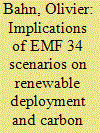

|
|
|
|
|
| Summary/Abstract |
This paper proposes a detailed analysis of the evolution of Canadian energy systems under some selected EMF (Energy Modeling Forum) 34 scenarios. Our analysis is based on NATEM, an energy model that follows the TIMES approach of the International Energy Agency to represent in detail the energy sector of each of the 13 Canadian provinces and territories. NATEM shows that imposing different renewable penetration constraints for electricity generation has limited impacts outside the electricity sector. In particular, greenhouse gas (GHG) emissions continue to increase over time. Conversely, the imposition of a carbon tax has broader impacts on Canadian energy systems and on GHG emissions that are almost stabilized. However, the level of the carbon tax envisions by the EMF 34 study (increasing to a maximum level of $130 per tonne by 2050) is not high enough, in a Canadian context, to trigger a decrease of GHG emissions over time as mandated by Canadian climate policies.
|
|
|
|
|
|
|
|
|
|
|
|
|
|
|
|
| 9 |
ID:
098773
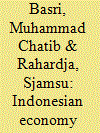

|
|
|
| 10 |
ID:
191184
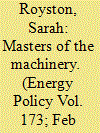

|
|
|
|
|
| Summary/Abstract |
Economic modelling plays a major role in the development, justification and evaluation of energy policies. However, there has been little investigation of how political dynamics systematically influence these models' development and outputs, or the implications for energy strategies, targets and interventions. Using in-depth interviews with 24 European modellers and policyworkers, we illuminate the politics of economic modelling within European Union (EU) energy policymaking, focusing on dynamics of contestation, differentiated influence and power relations within models' a) framing of questions and problems; b) framing of scenarios and solutions; c) structural assumptions and d) definition of quantitative data inputs. We then consider deeper questions of e) access and exclusion, showing how modelling is used to silence critical voices and reinforce incumbent interests. We argue that understanding this politics of modelling is crucial to the implementation of sustainable energy transitions. We conclude with recommendations for researchers and policyworkers seeking to promote the use of alternative/innovative models in energy policy (within and beyond the EU), centring on reflexivity; recognition; and relationship-building. Developing multi-sectoral ‘communities of practice’ around innovative modelling approaches is vital in challenging a vicious circle of evidence and policy that legitimises business-as-usual in a dangerously warming world.
|
|
|
|
|
|
|
|
|
|
|
|
|
|
|
|
| 11 |
ID:
160878
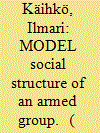

|
|
|
|
|
| Summary/Abstract |
This article investigates the Movement for Democracy in Liberia (MODEL) through a revised Weberian framework that focuses on legitimacy and offers a thick description of the different phases of this armed group. The article argues that the key to fostering cohesion is the harmonization of the micro, meso, and macro levels. This proved a difficult undertaking for the MODEL. Not only did the MODEL lack material resources but it also relied on different and evolving kinds of legitimacy on these levels. With its sources of legitimacy exhausted after the war, the MODEL ceased to exist.
|
|
|
|
|
|
|
|
|
|
|
|
|
|
|
|
| 12 |
ID:
167742
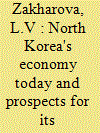

|
|
|
|
|
| Summary/Abstract |
This paper analyzes key development trends in the North Korean economy and its basic functioning principles; it examines the prospects for further transformation of the country's economic structure. Relaying on a systemic approach and method of simulation, the author presents a model of today's North Korean economy, and singles out several spheres therein that differ in management principles and mechanisms of decision-making by economic entities. The development forecast for the economic system of the country is given within the framework of four proposed scenarios based on a combination of the main internal and external factors.
|
|
|
|
|
|
|
|
|
|
|
|
|
|
|
|
| 13 |
ID:
084361


|
|
|
| 14 |
ID:
188022
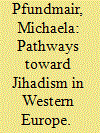

|
|
|
|
|
| Summary/Abstract |
Islamist terror is one of the most terrifying threats worldwide. However, there is no common model about the mechanisms underlying the complex process of radicalization and research is usually undermined by a lack of empirical data. Therefore, we aimed to compose a comprehensive model of radicalization, and test it empirically collecting and analyzing data on Islamist radicals in Western Europe. In Study 1, police professionals assessed seventy-five subjects under investigation for being in the process of radicalization. In Study 2, data from open source news articles about eighty six radical Muslims were evaluated by psychologists. Specific individual preconditions including young age, male gender, migration background, and biographical cuts were consistently found among radicals. Fueling the actual radicalization process, a gradual increase of individual, group and catalyst processes was observed from early (Study 1) to late stages of radicalization (Study 2). These included pursuing individual needs (transcendence, significance, self-esteem, control); processes in the course of a strong group commitment (group identification, prejudice, polarization, perceived group threat, collective emotions, informative influence); and cognitive adaptions to get increasingly comfortable with applying violence (desensitization, dehumanization). The current work may be a solid basis for further empirical investigations and for creating means of prevention and deradicalization.
|
|
|
|
|
|
|
|
|
|
|
|
|
|
|
|
| 15 |
ID:
090089


|
|
|
|
|
| Publication |
2009.
|
| Summary/Abstract |
Throughout history, energy resources have acquired a strategic significance for the economic growth and social welfare of any country. The large-scale oil crisis of 1973 coupled with various environmental protection issues, have led many countries to look for new, alternative energy sources. Biomass and fuelwood in particular, constitutes a major renewable energy source (RES) that can make a significant contribution, as a substitute for oil. This paper initially provides a description of the contribution of renewable energy sources to the production of electricity, and also examines the role of forests in the production of fuelwood in Greece. Following this, autoregressive integrated moving average (ARIMA) models, artificial neural networks (ANN) and a hybrid model are used to predict the future selling prices of the fuelwood (from broadleaved and coniferous species) produced by Greek state forest farms. The use of the ARIMA-ANN hybrid model provided the optimum prediction results, thus enabling decision-makers to proceed with a more rational planning for the production and fuelwood market.
|
|
|
|
|
|
|
|
|
|
|
|
|
|
|
|
| 16 |
ID:
014268


|
|
|
|
|
| Publication |
Sept 1992.
|
| Description |
395-414
|
|
|
|
|
|
|
|
|
|
|
|
|
|
|
|
| 17 |
ID:
090143
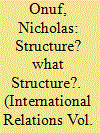

|
|
|
|
|
| Publication |
2009.
|
| Summary/Abstract |
Kenneth Waltz is a structural theorist. While scholars often comment on Waltz's conception of structure, they rarely address the philosophical assumptions behind it - assumptions that go back to Kant and finally to Aristotle. Appropriately situated, Waltz's conception of structure points to a strong version of constructivist social theory. To make my case, I trace Waltz's view of political structure in his early work, recapitulate his views on science, models and theory, address the question of his (or any) theory's relation to `reality', illustrate his difficulty with structural theory and institutional reality, and consider the vexed question of any theory's fit to a world already talked into existence. I show how close Waltz is to a philosophical position that solves his problem with theory's relation to reality and specifies the conditions under which any social theory can make sense or use of the term structure.
|
|
|
|
|
|
|
|
|
|
|
|
|
|
|
|
| 18 |
ID:
153738
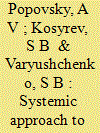

|
|
|
|
|
| Summary/Abstract |
The authors review conceptual issues related to using systems analysis to study structures designed to ensure radiation safety at military assets.
|
|
|
|
|
|
|
|
|
|
|
|
|
|
|
|
| 19 |
ID:
084464
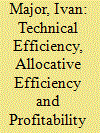

|
|
|
|
|
| Publication |
2008.
|
| Summary/Abstract |
By applying a simple model of frontier production functions, this article shows that Hungarian small and medium-sized enterprises (SMEs) produce far below their feasible level, given their input endowment. The SMEs' under-production is rooted in the allocative inefficiency of small and medium-sized firms: they use labour in excess while they lack a sufficient level of capital assets. As a consequence of large inefficiencies, Hungarian SMEs improve profitability by scaling down production rather than by expansion.
|
|
|
|
|
|
|
|
|
|
|
|
|
|
|
|
|
|
|
|
|